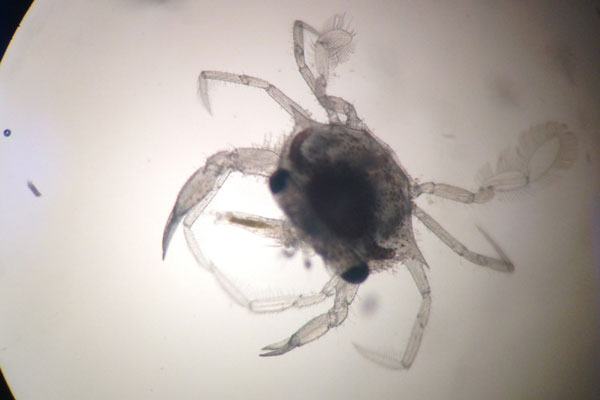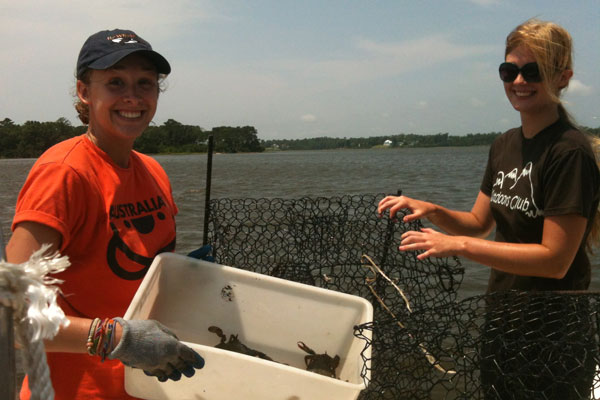
Andrew Goff and collaborators in Susanne Brander’s lab studied the effects of fipronil, an insecticide found in popular flea treatments, and its byproducts on juvenile crabs. Photo by Andrew Goff.
During flea season, many of us use treatments to protect our beloved pets and to prevent our homes from becoming infested. Frontline, a common flea treatment that contains the insecticide fipronil, renders everything from fleas to lice helpless by acting on the central nervous system of these unwanted invaders. It paralyzes and kills these insects within a couple of days. Lesser-known uses of fipronil include its addition to baited traps that eliminate cockroaches, and pellet formulations used to keep pesky tunneling mole crickets away from golf course greens.
As with most insecticides, there are always effects on other organisms. Aquatic invertebrates such as crabs and copepods, which are essentially bugs that swim, are highly sensitive to chemicals designed to target their insect cousins. Furthermore, because insecticides like fipronil are present in runoff (e.g., from golf courses) or found in treated wastewater effluent, aquatic invertebrates swim around in a veritable soup of chemicals their entire lives.
When an insecticide like fipronil gets into the environment, it gets tossed around in currents and waves, baked in the sunlight and broken down into different chemical byproducts. A recent study, partially funded by North Carolina Sea Grant, evaluated the eggs of adult female crabs for pesticide content in regional North and South Carolina estuaries.

Lauren Ryan, left, and Paige Millsap, right, collect crabs for Brander’s study. Photo courtesy Susanne Brander.
Researchers at the University of North Carolina Wilmington, in collaboration with the U.S. Geological Survey, found a byproduct of fipronil that is produced from exposure to sunlight, fipronil desulfynil, in a few of the crabs. These findings indicate that blue crabs are absorbing fipronil and its byproducts from the water. Fipronil gets bound to fatty tissues and concentrates in the eggs of female crabs that are exposed.
A team of researchers in the Brander lab, led by graduate student Andrew Goff, were interested in seeing the effects on the juveniles hatched from eggs with high fipronil content. Juvenile blue crabs obtained from a hatchery in Maryland were exposed in the lab to levels of fipronil found in the environment and also to its byproduct, fipronil desulfinyl. After just four days, these young juvenile crabs had altered growth rates and changes in the expression of genes that control growth and reproduction. Notably, fipronil desulfinyl caused more significant changes in gene expression than fipronil did.
Crabs exposed to the insecticide and its byproduct fipronil desulfinyl grew more quickly than those in the control group. While this may sound like a good thing, crabs must molt — lose their exoskeleton — to grow. Exposure to these chemicals in our estuaries may result in crabs molting more often, leaving them vulnerable to predators because they lose their hard protective outer shell. Furthermore, changes in genes that control molting and reproduction in juvenile crabs could contribute to reduced survival rates or lowered reproductive success later in life.
The effects of insecticide exposure are subtle and complex. Resource managers should consider the sensitivity of juvenile organisms to these chemicals and the repercussions of being exposed in early life. Future studies should look at the effects of early life exposure to fipronil and fipronil desulfinyl on mature crabs, and evaluate the mechanism by which fipronil and its byproducts disrupt growth and reproduction. An investigation of the use of fipronil pellets in coastal golf courses and the insecticide’s concentrations in estuarine waters also is warranted.
Given that estuaries serve as nurseries for a diversity of organisms, including many aquatic invertebrates, it is of vital importance that the results of studies like these are taken into consideration when insecticides are used in coastal areas, in our homes and beyond.
Read more about this research in our paper in Aquatic Toxicology, titled “The effects of fipronil and the photodegradation product fipronil desulfinyl on growth and gene expression in juvenile blue crabs, Callinectes sapidus, at different salinities” (DOI information: 10.1016/j.aquatox.2017.02.027).
Susanne Brander is an ecotoxicologist at the University of North Carolina Wilmington. She studies the responses of aquatic organisms to endocrine-disrupting compounds, with a focus on discerning mechanisms of toxicity and linking results of laboratory experiments to ecosystem responses.